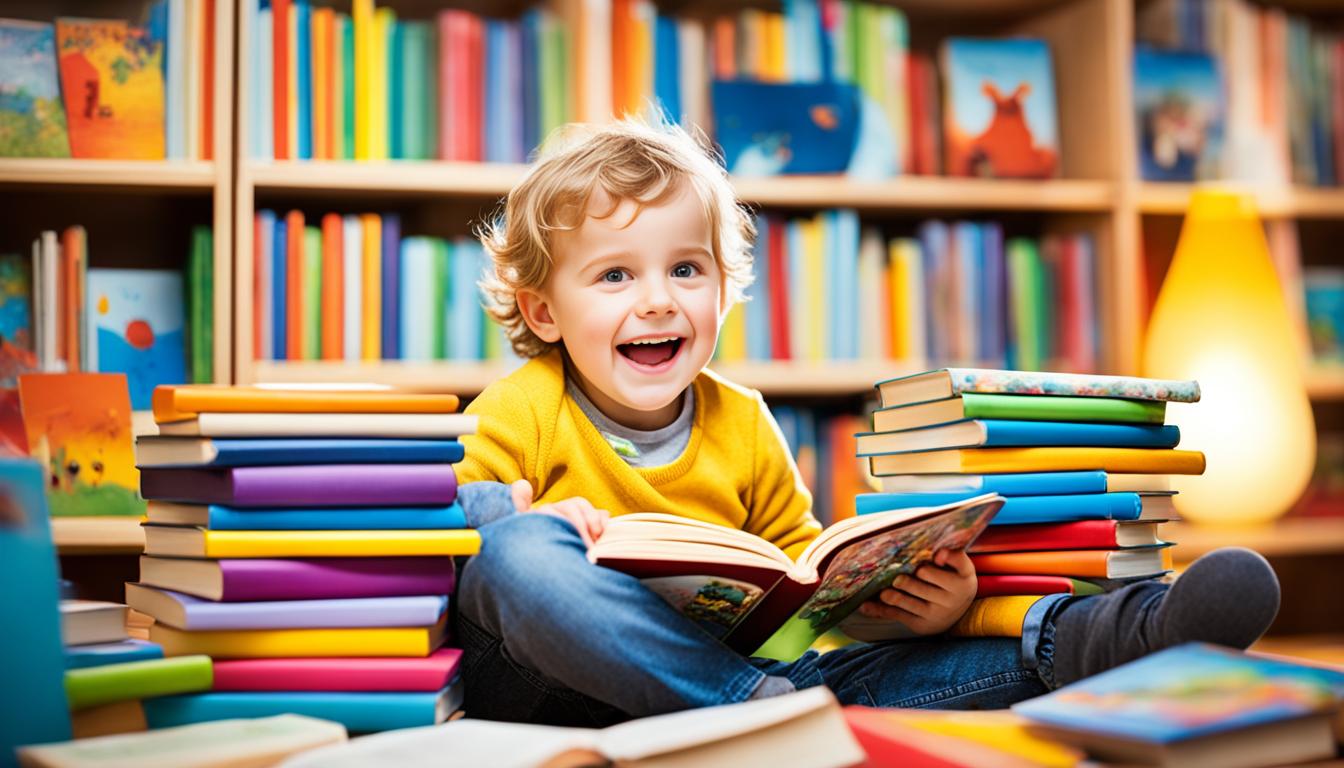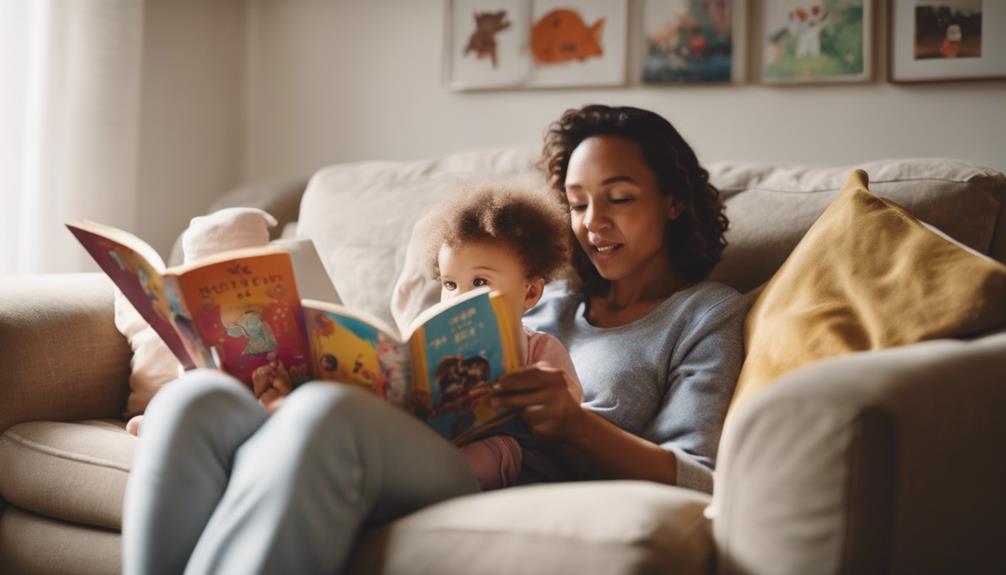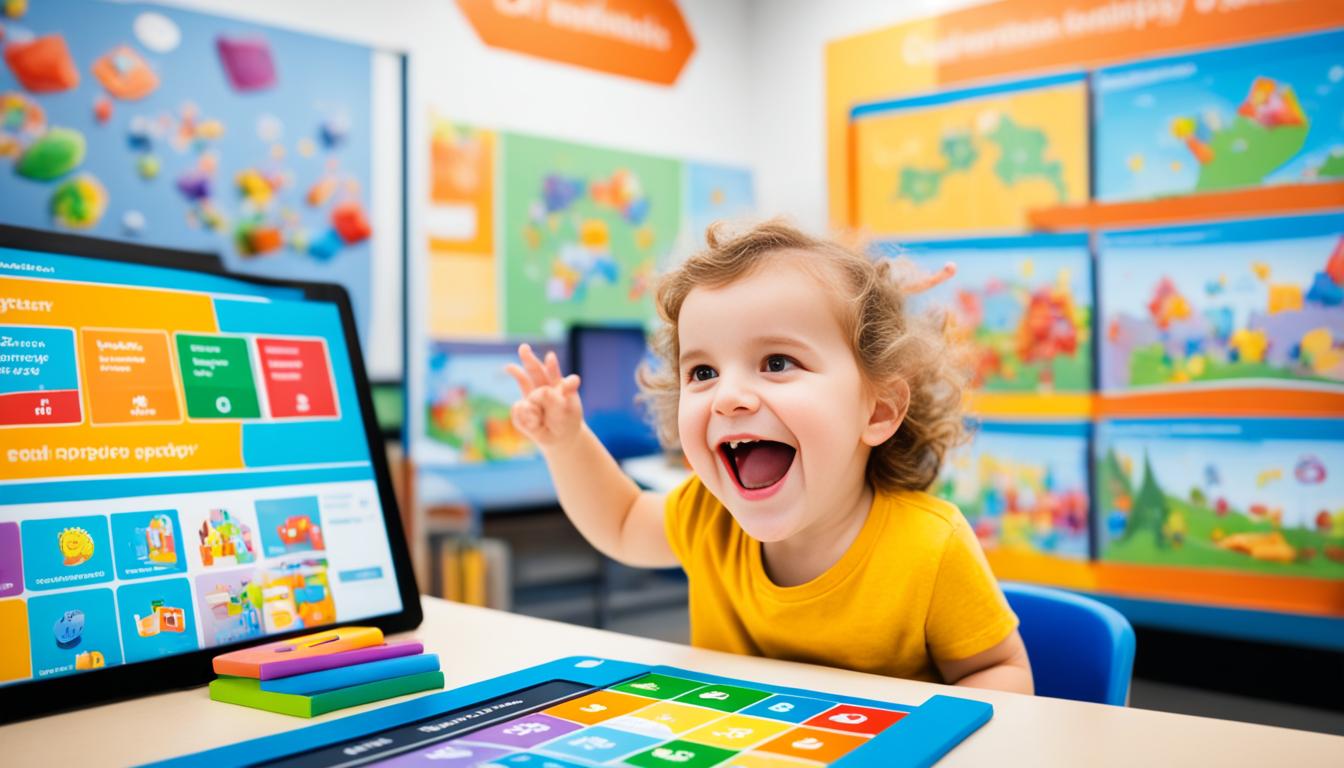Picture yourself comfortably seated in your preferred armchair, with your little one nestled beside you, keenly absorbing the captivating story you’re reading out loud. With every page you turn, their eyes light up with curiosity, their imagination reaching new levels. Unbeknownst to them, this basic activity is setting the groundwork for their eventual success and influencing their journey towards continuous learning.
Studies have shown that reading aloud to children up to 5 years old not only expands their vocabulary but also builds neural connections within these critical learning years, leading to better reading comprehension1. By engaging in early literacy activities like reading together, you’re not only fostering their love for reading but also helping them develop strong language and literacy skills that are essential for their academic and personal growth.
Key Takeaways:
- Promoting early literacy skills is crucial for a child’s future learning and success.
- Reading aloud to children up to 5 years old expands their vocabulary and builds neural connections1.
- Early literacy experiences stimulate brain development, enhance cognitive abilities, and foster critical thinking and problem-solving skills1.
- Engaging in literacy activities helps children develop social and emotional skills, such as empathy and emotional intelligence1.
- Providing access to a variety of books and literacy resources is crucial for early literacy development1.
The Importance of Early Literacy Development
Early literacy development is crucial for children’s overall development and future success. It encompasses various skills such as language acquisition, phonological awareness, print awareness, vocabulary building, and comprehension. By nurturing these skills in young children, we can empower them to become proficient readers and effective communicators, setting the stage for lifelong learning.
Research has shown that children who develop strong early literacy skills are more likely to succeed academically, exhibit higher levels of self-confidence, and actively engage in learning experiences1. Reading aloud to children up to the age of five helps expand their vocabulary and build neural connections, ultimately leading to better reading comprehension1. Additionally, various factors influence early literacy development, including early exposure to picture books and language, parental involvement, socioeconomic status, and the quality of early childhood education1.
Children who enter elementary school with a solid foundation in early literacy are better equipped to engage in classroom activities, follow instructions, and actively participate in learning1. Early literacy, therefore, plays a crucial role in preparing children for school by developing the necessary skills and knowledge1. Moreover, early literacy sets the stage for lifelong learning, instilling a love for reading and cultivating a positive attitude toward education1.
To enhance early literacy skills, it is essential to implement effective strategies and techniques. Reading aloud, creating a literacy-rich environment, engaging in conversations and storytelling, providing access to books and resources, and encouraging writing and drawing are all effective ways to promote early literacy1. Parents and primary caregivers play a significant role in fostering a love for reading, language, and learning from the very beginning1.
By understanding the importance of early literacy development and implementing appropriate approaches, we can empower children to reach their full potential, laying a strong foundation for their future academic and personal success.
Strategies to Promote Early Literacy
To enhance reading skills in children and foster early literacy interventions, there are several effective strategies that parents and caregivers can implement at home:
- Start early by reading to babies, even as young as age 1. This helps lay the foundation for language and writing skills2.
- Make reading a part of your daily routine to create a habit. Choose board and cloth books, which are suitable options for babies to grab and explore2.
- Take turns with your toddler during reading sessions. Engage them by asking questions and pointing at pictures in the book. This interactive experience enhances their engagement with reading and develops their literacy skills2 and3.
- Reread your child’s favorite books. Point out similar words and encourage them to recognize and read them, enhancing their reading skills2.
- Count objects on the page while reading with your preschooler. Encourage them to tell you the story, filling in the sentences and fostering their literacy skills2.
By implementing these strategies, parents and caregivers can enhance their child’s reading skills, promote early literacy development, and create a strong foundation for future academic success.

Building Literacy Skills in the Classroom
As an educator, you have the power to create a classroom environment that fosters the development of early literacy skills
. By implementing effective literacy building methods and promoting language and literacy skills, you can empower your students to become proficient readers and confident communicators.
One important aspect of building literacy skills in the classroom is ensuring that letters and words are easily viewable
. Displaying alphabets, sight words, and vocabulary charts can help students develop print awareness and expand their repertoire of words. When students are immersed in an environment rich with print, they are more likely to engage with text and develop literacy skills.
Another critical aspect is promoting phonological awareness
. Helping students recognize that language is made up of sounds will strengthen their ability to decode and encode words. Engage students in phonics activities, such as rhyming games, sound blending exercises, and syllable segmentation. These activities will enhance their ability to manipulate sounds and improve their reading and spelling skills.
Reading aloud to students is a powerful method for promoting literacy and language skills
. By engaging students in read-aloud sessions, you expose them to rich and engaging language, build their vocabulary, and develop their comprehension skills. Encourage students to ask questions, make predictions, and discuss the story to enhance their understanding and critical thinking abilities.
Creating a literacy-rich environment goes beyond letters and words
. Engage students in conversations and storytelling
. These activities provide opportunities for students to practice and develop their language and communication skills. By encouraging students to share their thoughts, express their ideas, and engage in meaningful discussions, you create a supportive and collaborative learning environment that promotes literacy development.
Incorporating technology can also enhance literacy skills in the classroom
. Utilize educational apps, interactive websites, and digital reading materials to engage students and provide diverse learning experiences. Platforms like Nearpod offer a wide range of standards-aligned lessons, videos, and activities that can support literacy development
.
In conclusion, as an educator, you have the opportunity to build strong literacy skills in your students
. By creating a literacy-rich environment, promoting phonological awareness, engaging in read-alouds, fostering conversations and storytelling, and incorporating technology, you can empower your students to become lifelong readers and effective communicators.
The Benefits of Early Literacy
Early literacy skills have numerous benefits for children. These skills not only prepare them for school, but also enhance their cognitive abilities and develop their language and communication skills. Engaging in early literacy experiences contributes to children’s social and emotional development, fostering a love for reading and learning that lasts a lifetime1.
Research has shown that children who develop strong early literacy skills are more likely to succeed academically while exhibiting higher levels of self-confidence and active engagement in learning experiences1. By fostering literacy in young children, we empower them to achieve their full potential and boost their self-esteem.
Early exposure to picture books and language, parental involvement, socioeconomic status, and the quality of early childhood education all play important roles in early literacy development1. Children who enter elementary school with a solid foundation in early literacy are better prepared to engage in classroom activities, follow instructions, and actively participate in learning, promoting school readiness1.
Furthermore, the skills acquired in the first three years of a child’s life serve as building blocks for their future academic success. Educators reinforce these skills throughout grade levels, with children achieving a substantial vocabulary by third grade and developing writing skills in fourth grade1.
Early literacy experiences also instill a love for reading and learning, creating a positive attitude toward education1. By fostering a literacy-rich environment, engaging in meaningful literacy activities, and providing necessary support and resources, we can promote early literacy development, leading to strong literacy skills and a lifelong love for reading and learning1.
The nurturing of a love for reading begins at home. Parents and caregivers can set a positive example by reading aloud to their children, establishing reading routines, and supporting language development1. Collaborating with early childhood educators further contributes to strong early literacy development for lifelong success1.

Encouraging a Lifelong Love of Reading

Reading books can have a profound impact on children’s development beyond language and literacy skills. It encourages intellectual curiosity, problem-solving, empathy, and self-esteem. By fostering a love of reading from an early age, you can promote language and literacy skills while nurturing a lifelong passion for learning.
Allowing children to choose the books they are interested in empowers them to engage with topics that captivate their imagination and fuel their curiosity. Whether it’s a thrilling adventure, a fascinating non-fiction book, or a beloved classic, giving children the agency to select their reading material fosters a sense of ownership and excitement.
Creating a comfortable reading area in the classroom can further enhance the reading experience. Design a cozy and inviting space where children can relax and immerse themselves in the stories they explore. Add soft cushions, bean bags, or rugs to provide a comfortable seating arrangement. This dedicated reading nook becomes a sanctuary for children to escape into the world of books.
Research has shown that children who are read to frequently show increased IQ levels7. By regularly exposing children to the joy of storytelling, we can help them develop their cognitive abilities while cultivating their love for reading.
Establishing reading routines is also crucial in promoting a lifelong love of reading. Set aside dedicated time each day to share stories with children. Whether it’s a bedtime routine or a special reading session after lunch, consistency plays a vital role in creating reading habits.
Make reading a sacred ritual, a moment where children can connect with you and with the magical worlds that stories unfold. Encourage interaction during reading sessions by asking open-ended questions and allowing children to express their thoughts and reactions to the story. This interactive approach not only strengthens language and literacy skills but also deepens the bond between you and the child.
Children benefit from hearing stories read aloud long after they learn to read independently7. By embracing shared reading experiences, we can instill a lifelong love of reading and learning in children.
As educators, it is crucial to set a positive example and create an environment that fosters a love of learning and reading. Let your passion for literature shine through and share your favorite books and authors with children. Encourage discussions about books and provide opportunities for children to express their opinions, ideas, and interpretations.
Incorporate reading-related activities and projects that engage with the texts children are exploring. For example, create art projects inspired by the illustrations in their favorite books, organize book-themed dress-up days, or invite authors to visit the classroom and share their writing journey.
Remember, reading is not just a means to acquire knowledge but a journey that sparks imagination, empathy, and critical thinking skills. By promoting language and literacy skills and fostering a lifelong love of reading, we empower children to become curious, engaged, and lifelong learners.
Let’s collaborate with parents and caregivers to ensure a holistic approach to early literacy. By working together and aligning strategies to promote early literacy development, we can create a supportive and enriching environment that nurtures children’s language and literacy skills and sets them on a path toward a bright future.
The Role of Parents and Caregivers in Early Literacy
Parents and caregivers play a crucial role in promoting early literacy skills and setting a solid foundation for their children’s educational journey. By fostering a love for reading and implementing effective literacy promotion techniques, they can support language development and ensure future academic success.
Research shows that by age 2, a child can typically understand approximately 300 words and communicate using one-to-two word combinations8. By age 3, their vocabulary comprehension expands to about 900 words, and they can speak around 200 words clearly8. As they enter the age of 4, children can comprehend up to 2,000 words and are capable of forming sentences with four to seven words8. By age 5, their word understanding expands to approximately 2,800 words, and they can express themselves using up to 2,000 words8.
Parent involvement is considered the number one predictor of early literacy success and future academic achievement9. It is more essential than ever to cultivate a home environment that promotes early literacy and language development. According to a 2007 report by the National Endowment for the Arts, there are more literate individuals in the United States who do not actively read than those who are genuinely illiterate9. Recent research has also emphasized that reading on its own may not sufficiently enhance pre-literacy skills9.
Children should not only be read to but also provided with specific skills during reading sessions to succeed in their early literacy development9. Parents should focus on the words on the page while reading with their preschool-aged child to enhance their literacy success9.
Parents and caregivers serve as models for language use, communication, and reading behaviors, shaping children’s attitudes toward reading and learning9. Engaging in meaningful conversations, supporting language development through daily interactions, and collaborating with early childhood educators are vital literacy promotion techniques9. They provide children with the necessary skills and motivation to navigate through the early stages of literacy development successfully. By nurturing a positive reading culture at home, parents and caregivers establish a strong foundation for their children’s language and literacy skills.
To further support parents and caregivers, numerous resources are available. The National Institute for Literacy has released the “Developing Early Literacy: Report of the National Early Literacy Panel”10. Additionally, the U.S. Department of Health and Human Services Office of the Administration for Children and Families Early Learning & Knowledge Center offers online resources, including an activities handbook and a foundational curriculum for parents and families to act as teachers10. These resources provide valuable guidance and tools for promoting early literacy at home.
By empowering parents and caregivers with knowledge, skills, and resources, we can create supportive environments that foster early literacy and set children on a path to lifelong learning and success.
The Impact of Early Literacy on School Readiness
Developing strong early literacy skills in children is crucial for their school readiness and overall academic success. Studies have shown a significant correlation between early literacy development and achievement in school11. Key predictors of reading and school success include oral language, Alphabetic Code, and print knowledge11.
Early literacy skills begin to develop between the ages of 3 to 5 years, during the preschool period. This includes phonological awareness, print awareness, and alphabet knowledge12. By cultivating these skills at an early age, children are better equipped to engage in classroom activities, follow instructions, and actively participate in learning.
The skills learned during the early years of a child’s life serve as the foundation for future academic success. They form the building blocks for continued learning, as children progress through each grade level11. Early literacy development encompasses more than just learning to read and write; it includes language acquisition, vocabulary building, and comprehension skills11.
Children who fall behind in oral language and literacy development before formal schooling are less likely to be successful beginning readers11. Parents and caregivers play a crucial role in promoting early literacy skills and ensuring their child’s school readiness. By providing rich language and literacy support at home, children are better prepared for the academic challenges they will face11.
It is important to note that children from families with financial challenges may face additional barriers to early literacy development. Families with lower incomes may not have access to children’s books in their homes13. This creates a significant gap in exposure to words and impacts children’s vocabulary acquisition, which is vital for reading achievement13. It is imperative to address these socioeconomic disparities and provide adequate resources and support to ensure that all children have an equal opportunity to develop strong early literacy skills.
Overall, enhancing reading skills in children through early literacy development has a profound impact on their school readiness and academic journey. By creating a nurturing environment at home and in educational settings, we can empower children to become confident and successful learners.

Strategies for Promoting Early Literacy at Home
Promoting language and literacy skills in young children is crucial for their overall development and future success. As a parent or caregiver, there are various strategies you can utilize to create a literacy-rich environment at home and foster a love for reading and learning. By implementing these early childhood literacy activities, you can lay a strong foundation for your child’s language and literacy skills.
Nurturing a Love for Reading
One of the most effective ways to promote early literacy is by nurturing a love for reading. Set aside dedicated time each day for reading together as a family. Choose books that align with your child’s interests and encourage active engagement during reading sessions. Reading aloud with enthusiasm and emotion can positively impact your child’s retention of words and enhance their enjoyment of reading material.
Setting a Positive Example
Children learn by example, so be a reading role model for your child. Let them see you engaged in reading books, magazines, or newspapers. Share your enthusiasm for reading and discuss the stories or information you’ve learned. Modeling reading behavior sets a powerful example and fosters a love for books and storytelling.
Establishing Reading Routines
Consistency is key when it comes to promoting early literacy. Establish specific times for reading, whether it’s a bedtime story or a quiet reading session during the day. Make reading a part of your daily routine, just like eating meals or brushing teeth. By incorporating reading into your child’s routine, you create a reading culture at home and emphasize the importance of literacy.
Supporting Language Development
Language development is closely linked to literacy skills. Encourage your child to express themselves verbally and engage in conversations. Ask open-ended questions to spark their curiosity and critical thinking. Provide opportunities for storytelling, imaginative play, and vocabulary-building activities. Research shows that a child’s vocabulary size during the preschool years is positively correlated with their reading comprehension skills later in life14.
Access to Books and Resources
Make sure your home is filled with books and reading materials to create a print-rich environment. Set up a cozy reading corner or a designated spot by the bookshelf where your child can explore and choose books independently. Visit the library regularly and allow your child to select books that interest them. Providing access to diverse genres and topics allows children to explore different experiences and perspectives15.
Encouraging Writing and Drawing
Early literacy activities go beyond reading. Encourage your child to engage in writing and drawing as well. Provide them with age-appropriate writing tools, such as crayons or markers, and paper or notebooks. Encourage them to draw pictures and tell stories through their illustrations. As they progress, introduce simple writing activities like tracing letters or writing their names14.
Using Technology to Enhance Literacy Experiences
In today’s digital age, technology can be a valuable tool to enhance early literacy experiences. Utilize educational apps or interactive e-books that promote reading skills and language development. However, it’s important to monitor screen time and ensure that technology is used as a supplement, not a replacement, for traditional reading experiences.
“Reading is a gateway to curiosity, problem-solving, empathy, self-esteem, understanding of the world, and connections with others. Encouraging a lifelong love of reading can yield these benefits to children.” 2
By implementing these strategies and creating a nurturing environment, you can promote language and literacy skills in your child and instill a lifelong love for reading. Remember, early literacy development starts at home and plays a crucial role in your child’s future academic success and overall well-being.

Educating Educators on Early Literacy Skills
As an educator, understanding the importance of promoting early literacy skills is crucial for fostering a strong foundation for learning and academic success. By implementing effective literacy development strategies, you can empower your students to become proficient readers and active learners.1
Why Early Literacy Skills Matter
Developing early literacy skills is essential for healthy brain development and has been associated with higher academic achievements later in schooling. Research shows that children who enter elementary school with a solid foundation in early literacy are better equipped to engage in classroom activities, follow instructions, and actively participate in learning.16
“Children who develop strong early literacy skills are more likely to succeed academically, exhibit higher levels of self-confidence, and actively engage in learning experiences.”1
Effective Strategies for Promoting Early Literacy
There are various literacy development strategies that educators can implement in the classroom to promote early literacy skills. Reading aloud to children is a powerful way to expose them to language, expand their vocabulary, and build neural connections. Creating a literacy-rich environment with a wide variety of books and resources encourages reading engagement. Engaging in conversations, storytelling, and providing opportunities for writing and drawing further enhance literacy skills. Integrating technology tools, such as Nearpod’s Immersive Reader feature, can support students with visual impairments or language learning needs.116
“Strategies to promote early literacy include reading aloud to children, creating a literacy-rich environment, engaging in conversations and storytelling, providing access to books and resources, encouraging writing and drawing, and using technology for literacy enhancement.”1
Incorporating Evidence-Based Approaches
Keeping up with evidence-based approaches to literacy instruction is essential for effective teaching. For example, the Science of Reading emphasizes the importance of phonics instruction and understanding the alphabetic principle. Invented spelling can be used as an assessment tool to evaluate a student’s phonetic decoding ability. Nearpod’s library offers a range of teaching resources and interactive activities to enhance reading skills.16
“Teaching strategies like the Science of Reading and using Nearpod’s library focus on developing reading skills.”16
Supporting Children Across Literacy Development Stages
Children’s literacy development progresses through different stages. In the pre-literacy stage, they start linking sounds they hear with words they see. During the emergent literacy stage, they recognize letters and understand how print runs from left to right and top to bottom. In the transitional literacy stage, they experiment with reading and writing more complex sentences and simple poems. Ultimately, as experienced readers, they can read independently, understand and analyze texts, and express their ideas in writing.17
“Pre-Literacy Stage (Birth to Age 3): Children start to link sounds they hear with words they see.
Emergent Literacy (Ages 3 to 4): Children recognize letters and understand that print runs from left to right, top to bottom.
Transitional Literacy (Ages 5 to 6): Children experiment with reading and writing, may write simple poems and sentences.
Experienced Reader (Ages 6 and Beyond): Children can read independently, comprehend text, and express ideas in writing.”17
Educator’s Role in Promoting Early Literacy
As an educator, you play a critical role in nurturing a love for reading and promoting early literacy skills. By setting a positive example, establishing reading routines, and creating a language-rich environment, you can foster a lifelong passion for learning in your students. Collaborating with parents and caregivers is also essential for supporting language development and reinforcing early literacy skills beyond the classroom. Together, we can empower children to unlock their full potential through early literacy education.117
The Lifelong Impact of Early Literacy
Early literacy development has a lasting impact on individuals, shaping their lifelong journey of learning and discovery. By promoting language and literacy skills in children, we can unlock their full potential and foster a love for reading that extends far beyond their early years.
Studies show that literacy development is highly correlated with school achievement11. Limited experiences with language and literacy increase the likelihood of difficulties in learning to read11. Key predictors of reading and school success include oral language, Alphabetic Code, and print knowledge11.
By prioritizing early literacy, we can provide children with a strong foundation for future academic success. Program accountability focuses heavily on assessments of children’s early literacy development11, highlighting the importance of early intervention and support. Highly capable teachers play a pivotal role in implementing challenging early literacy curriculum11.
Furthermore, parent involvement programs with early literacy components are essential for guiding parents in offering literacy experiences at home11. Children reared in language-rich environments perform better in school, demonstrating the powerful impact of their surroundings11. Exposure to sophisticated vocabulary at home contributes to children’s vocabulary acquisition and overall literacy development11.
A strong relationship exists between vocabulary development and reading achievement11. Childhood experiences greatly influence the ability to comprehend written texts11. Children who fall behind in oral language and literacy development before formal schooling are less likely to be successful readers11. Responsive adults, whether parents or educators, play a crucial role in supporting children’s ongoing learning11. Shared book reading experiences also play a vital role in early literacy development11. Standards for early childhood professionals should meet early literacy instructional requirements11. Assessment of early literacy should involve multiple methods and be used to enhance teaching and preschool programs11.
Early literacy goes beyond academic success. It paves the way for a lifetime of curiosity, critical thinking, and self-discovery. Individuals who develop strong reading skills in their early years are more likely to become lifelong learners, continuously seeking knowledge and engaging in intellectual pursuits. They possess a solid foundation that enables them to navigate various subjects, not just language arts18.
Children from lower-income homes may face challenges in literacy development, as they may hear 30 million fewer words by age 3 compared to their higher-income counterparts18. However, quality early childhood education programs with engaging literacy activities can bridge this gap and set a solid foundation for literacy development18. It is crucial to recognize the unique needs of children from multilingual backgrounds and ensure that educational systems support their literacy development18.
The DIBELS (Dynamic Indicators of Basic Early Literacy Skills) test serves as a valuable tool in assessing early literacy skills from kindergarten through sixth grade18. Regular exposure to books encourages children to understand sequencing and recognize cause-and-effect relationships, which are crucial for reading comprehension18. Enrolling children in high-quality early literacy programs can offer significant literacy advantages18. While educational technology can enhance traditional literacy development, it is crucial to balance screen time with other activities for a holistic approach to learning18.
By understanding the lifelong impact of early literacy and implementing effective strategies, we can enhance reading skills in children and promote language fluency and overall literacy development. Early literacy sets the stage for continuous learning, instills a love for reading, and creates a positive attitude toward education. Let us invest in early literacy today to empower children and shape their future.
| Benefits of Early Literacy | Strategies for Promoting Early Literacy |
|---|---|
| Prepares children for school | Start early by reading to babies |
| Enhances cognitive abilities | Make reading a part of your daily routine |
| Develops language and communication skills | Use board and cloth books for babies |
| Contributes to social and emotional development | Take turns with your toddler and ask questions |
| Lays the foundation for lifelong learning | Reread your child’s favorite books and point out similar words |
Remember, every effort to promote early literacy in children contributes to their personal growth and academic success. Together, let’s nurture a generation of lifelong learners by enhancing their reading skills and promoting language and literacy skills from the very beginning.

Conclusion
Promoting early literacy skills is essential for children’s development and future success. By implementing effective strategies in the classroom and at home, we can foster a love of reading, enhance language and literacy skills, and prepare children for lifelong learning. Research shows that reading aloud to children up to 5 years old helps expand their vocabulary and build neural connections, leading to better reading comprehension1. Early literacy experiences stimulate brain development and enhance cognitive abilities, fostering critical thinking, problem-solving, and memory skills1. High-quality early literacy experiences also promote language and communication skills, helping children develop strong communication abilities1.
Children who enter elementary school with a solid foundation in early literacy are better equipped to engage in classroom activities, follow instructions, and participate actively in learning1. In fact, research indicates that children who develop early literacy skills are more likely to become lifelong learners, continuously seeking knowledge and engaging in intellectual pursuits1. Implementing effective strategies to promote early literacy, such as reading aloud, creating a literacy-rich environment, engaging in conversations and storytelling, and providing access to books and resources, fosters strong literacy skills in children1.
Parents and caregivers play a pivotal role in nurturing a love for reading, language, and learning from the very beginning, which is essential for creating strong early literacy development and setting the stage for lifelong success1. By collaborating with families and organizing literacy-focused events and workshops, parents and caregivers can actively contribute to their child’s literacy journey19. Educators also play a crucial role in promoting early literacy skills by tailoring instruction based on each child’s needs, creating literacy-enriched learning environments, and implementing play-based literacy activities19.
In conclusion, promoting early literacy skills is a critical aspect of education. By engaging parents, caregivers, and educators in a collaborative effort, we can lay the foundation for children’s future success, empower them to become skilled readers and effective communicators, and nurture bright futures for young learners19. Let us continue to prioritize early literacy development and create a love for reading and learning that will last a lifetime.
FAQ
Why is promoting early literacy skills important?
What does early literacy development entail?
What strategies can be used to promote early literacy?
How can educators promote early literacy in the classroom?
What are the benefits of early literacy?
How can a love of reading be encouraged?
What role do parents and caregivers play in promoting early literacy?
How does early literacy impact school readiness?
What strategies can be implemented to promote early literacy at home?
How can educators be educated on early literacy skills?
What is the lifelong impact of early literacy?
Source Links
- https://www.voyagersopris.com/vsl/blog/the-power-of-early-literacy
- https://www.startearly.org/post/12-tips-to-boost-early-literacy/
- https://www.edutopia.org/article/early-literacy-strategies-work/
- https://www.readingrockets.org/topics/classroom-management/articles/literacy-rich-environments
- https://nearpod.com/blog/early-literacy-skills/
- https://www.panoramaed.com/blog/building-early-literacy-skills
- https://triadmomsonmain.com/my-blog/ellens-book-nook-tips-to-encourage-a-lifelong-love-of-reading/
- https://www.pacer.org/ec/early-literacy/parents-play-a-key-role.asp
- https://www.edutopia.org/blog/parent-involvement-in-early-literacy-erika-burton
- https://www.nichd.nih.gov/health/topics/early-learning/conditioninfo/promote
- https://www.readingrockets.org/topics/policy-politics-statistics/articles/early-literacy-policy-and-practice-preschool-years
- https://sjcpl.org/news/storytime-critical-for-developing-early-literacy-skills/
- https://lblreaders.org/why-early-literacy-matters/
- https://www.hanen.org/Helpful-Info/Early-Literacy-Corner/Literacy-at-Home.aspx
- https://extension.psu.edu/programs/betterkidcare/news/promoting-early-literacy-and-fostering-a-love-for-reading
- https://nearpod.com/blog/early-literacy-skills
- https://teachkloud.com/early-childhood-education/promoting-early-literacy-a-guide-for-early-childhood-teachers
- https://www.tutorlyft.com/blogs/the-importance-of-early-literacy
- https://www.parent.app/blog/promoting-early-literacy-development










